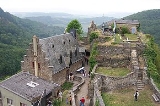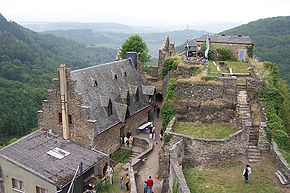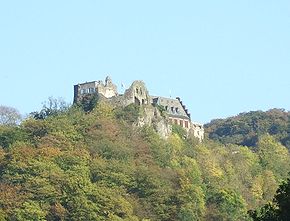
Schloss Veldenz
Encyclopedia


Moselle River
The Moselle is a river flowing through France, Luxembourg, and Germany. It is a left tributary of the Rhine, joining the Rhine at Koblenz. A small part of Belgium is also drained by the Mosel through the Our....
Valley region is a Castle
Castle
A castle is a type of fortified structure built in Europe and the Middle East during the Middle Ages by European nobility. Scholars debate the scope of the word castle, but usually consider it to be the private fortified residence of a lord or noble...
ruin about 1.5 kilometers southeast of Veldenz
Veldenz
Veldenz is an Ortsgemeinde – a municipality belonging to a Verbandsgemeinde, a kind of collective municipality – in the Bernkastel-Wittlich district in Rhineland-Palatinate, Germany...
.
Location
The site is located in the Rhineland-PalatinateRhineland-Palatinate
Rhineland-Palatinate is one of the 16 states of the Federal Republic of Germany. It has an area of and about four million inhabitants. The capital is Mainz. English speakers also commonly refer to the state by its German name, Rheinland-Pfalz ....
in the county of Bernkastel-Wittlich
Bernkastel-Wittlich
Bernkastel-Wittlich is a district in Rhineland-Palatinate, Germany. It is bounded by the districts of Vulkaneifel, Cochem-Zell, Rhein-Hunsrück, Birkenfeld, Trier-Saarburg and Bitburg-Prüm.- History :...
. It is situated on a mountain spur roughly 320 meters above sea level and 180 above the level of the Mosel.
It is located on the slopes of the Hunsrück
Hunsrück
The Hunsrück is a low mountain range in Rhineland-Palatinate, Germany. It is bounded by the river valleys of the Moselle , the Nahe , and the Rhine . The Hunsrück is continued by the Taunus mountains on the eastern side of the Rhine. In the north behind the Moselle it is continued by the Eifel...
in a side valley of the Moselle through which the Veldenzer Bach. The town of Bernkastel-Kues
Bernkastel-Kues
Bernkastel-Kues is a well-known winegrowing centre on the Middle Moselle in the Bernkastel-Wittlich district in Rhineland-Palatinate, Germany...
is located four kilometres northeast, the county town of Wittlich
Wittlich
The town of Wittlich is the seat of the Bernkastel-Wittlich district in Rhineland-Palatinate, Germany, and thereby the middle centre for a feeder area of 56 municipalities in the Eifel and Moselle area with its population of roughly 64,000...
is about 15 kilometres northwest, and the nearest big city
City
A city is a relatively large and permanent settlement. Although there is no agreement on how a city is distinguished from a town within general English language meanings, many cities have a particular administrative, legal, or historical status based on local law.For example, in the U.S...
is Trier
Trier
Trier, historically called in English Treves is a city in Germany on the banks of the Moselle. It is the oldest city in Germany, founded in or before 16 BC....
31 km southwest (all distances in a straight line]).
History
The first written reference to the castle was in the year 1156 (possibly a few years earlier). Frederick IFrederick I, Holy Roman Emperor
Frederick I Barbarossa was a German Holy Roman Emperor. He was elected King of Germany at Frankfurt on 4 March 1152 and crowned in Aachen on 9 March, crowned King of Italy in Pavia in 1155, and finally crowned Roman Emperor by Pope Adrian IV, on 18 June 1155, and two years later in 1157 the term...
(Barbarossa) confirmed the holding by Bishop Albert I of Verdun
Bishopric of Verdun
The Bishopric of Verdun was also a state of the Holy Roman Empire; it was located at the western edge of the Empire and was bordered by France, the Duchy of Luxembourg, and the Duchy of Bar. It was annexed to France in 1552; this was recognized by the Holy Roman Empire in the Peace of Westphalia of...
of the castle together with the surrounding land.
Since the 12th Century, the Counts of Veldenz have been the feudal lords of the land and the castle which became centre of the County of Veldenz. In 1286 Rudolf von Habsburg granted Veldenz city and market charters
Charters
Charters is a surname and may refer to :* Ann Charters , American professor of English* Charlie Charters , former English rugby union official and sports marketing executive* Frank Charters, , English cricketer...
.
In 1444 the castle and surrounding area came into the possession of the Counts of Pfalz-Zweibrücken due to the extinction of the Veldenz male line. They and their successors remained in possession of the Castle and county until the year 1694, even though during the intervening Thirty Years War followed approximately 150 years later by the Palatinian Succession War
War of the Grand Alliance
The Nine Years' War – often called the War of the Grand Alliance, the War of the Palatine Succession, or the War of the League of Augsburg – was a major war of the late 17th century fought between King Louis XIV of France, and a European-wide coalition, the Grand Alliance, led by the Anglo-Dutch...
the castle was occupied by Swedish, Spanish and French troops.
Finally in 1681, the castle was destroyed. In the following years, the owner moved and often used the ruin as a quarry, over time it belonged to the Kurpfalz and Bavaria
Bavaria
Bavaria, formally the Free State of Bavaria is a state of Germany, located in the southeast of Germany. With an area of , it is the largest state by area, forming almost 20% of the total land area of Germany...
. Since 1807, it is in private hands and is now owned by the Haufs-Brusberg family.
Today

Mittelmosel
The name Mittelmosel refers to the approximately 120-kilometer section of the river Moselle, in the state of Rhineland-Palatinate in Germany from the city of Trier to Zell...
. This fact explains the apparently still used term "castle". At the same time the 'castle' name is also a distinctive feature of Burg Veldenz in Nohfelden
Nohfelden
Nohfelden is a municipality in the district of Sankt Wendel, in Saarland, Germany. It is situated approx. 15 km north of Sankt Wendel, and 20 km southwest of Idar-Oberstein....
.
The extensive ruins of the keep
Keep
A keep is a type of fortified tower built within castles during the Middle Ages by European nobility. Scholars have debated the scope of the word keep, but usually consider it to refer to large towers in castles that were fortified residences, used as a refuge of last resort should the rest of the...
were structurally secured and partly rebuilt in the 19th Century. They are on a height on three sides of a steep mountain spur. they are almost 100 metres long and 30 metres wide.
On the main defensive side in the north and similarly on the southern flank there is a powerful Bastion
Bastion
A bastion, or a bulwark, is a structure projecting outward from the main enclosure of a fortification, situated in both corners of a straight wall , facilitating active defence against assaulting troops...
. The keep
Keep
A keep is a type of fortified tower built within castles during the Middle Ages by European nobility. Scholars have debated the scope of the word keep, but usually consider it to refer to large towers in castles that were fortified residences, used as a refuge of last resort should the rest of the...
in the East was not rebuilt, in contrast to the Palace
Palace
A palace is a grand residence, especially a royal residence or the home of a head of state or some other high-ranking dignitary, such as a bishop or archbishop. The word itself is derived from the Latin name Palātium, for Palatine Hill, one of the seven hills in Rome. In many parts of Europe, the...
with its distinctive Crow-stepped gable
Crow-stepped gable
A Stepped gable, Crow-stepped gable, or Corbie step is a stair-step type of design at the top of the triangular gable-end of a building...
, which is now used as a restaurant.
Literature
- Alexander Thon/Stefan Ulrich, "Von den Schauern der Vorwelt umweht...". Burgen und Schlösser an der Mosel, Regensburg: Schnell & Steiner 2007, S. 148-153. ISBN 978-3-7954-1926-4

